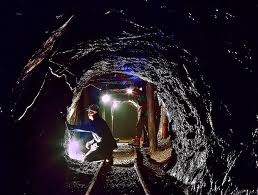Main Listing Page
Mining In Wales. A Long Time Ago
Mining has long been a staple occupation in Wales starting in small-scale in the pre-Roman British Iron Age and passing to an industrial scale after the conquest of the Romans in 78 AD. . Substantial quantities of gold, copper, and lead were extracted, along with lesser amounts of zinc and silver. Mining would continue until the process was no longer practical or profitable, at which time the mine would be abandoned. The extensive excavations of the Roman operations at Dolaucothi provide a picture of the high level of Roman technology and the expertise of Roman engineering in the ancient era.
Gold mining was sophisticated and technologically advanced at Dolaucothi, suggesting that the Roman army itself pioneered exploitation at the site. The construction of such dewatering machines is described by the Roman engineer Vitruvius writing in 25 BC, and their use for irrigation and lifting water in thermae was widespread.
The Romans were the first to extensively mine for gold and lead. One of the largest lead mines was at Cwmystwth where in the 18th century silver was also mined. Dolaucothi near Pumpsaint is the site of a Roman gold mine, the only one in Britain. The gold near the surface was exploited by open-cast working and the deeper ore was reached underground by galleries. The galleries were drained by a timber water-wheel, part of which can be seen in the National Museum in Cardiff. Each wheel would have been worked like a tread wheel, from the side rather than at the top, but it would have been a hard and lonely activity for the miners working these wheels lifting water from the mine bottom. Since the fragment of a reverse overshot water-wheel was found 160 feet below, it must have been part of a similar sequence at Dolaucothi to that in Spain. Underground coal mining began in Wales over 400 years ago.
In the past, superstitions were rife in all the coal mining communities and were always heeded!
In South Wales, Friday is associated with bad luck. Miners refuse to start any new work on a Friday and pit-men always stayed away from the mines on Good Friday throughout Wales.
In 1890 at Morfa Colliery near Port Talbot, a sweet rose-like perfume was noted. The perfume was said to be coming from invisible 'death flowers'. On March 10th half the miners on the morning shift stayed at home. Later that day there was an explosion at the colliery and 87 miners were buried alive and subsequently perished in the disaster.
A robin, pigeon and dove seen flying around the pit head foretold of disaster. They were called 'corpse birds' and were said to have been seen before the explosion at Senghennydd Colliery in Glamorgan in 1913 when 400 miners died.
Many precautions against bad luck were taken. If a 'squinting' woman was met on the way to work, the miner would go back home again. The women-folk also tried to banish any bad luck. When lots were being drawn for a position at the coal face, the miner's wife would hang the fire-tongs from the mantle-piece and put the family cat in the un-lit oven!




